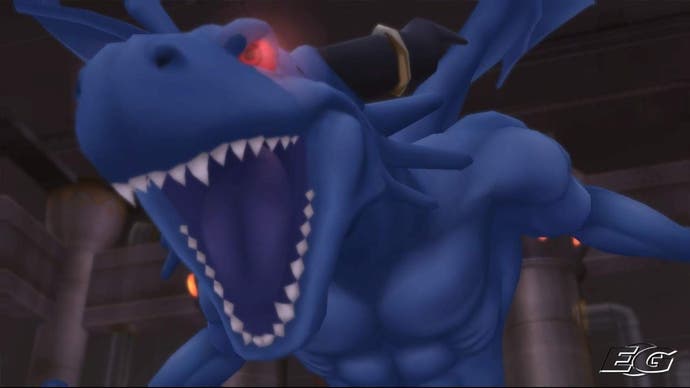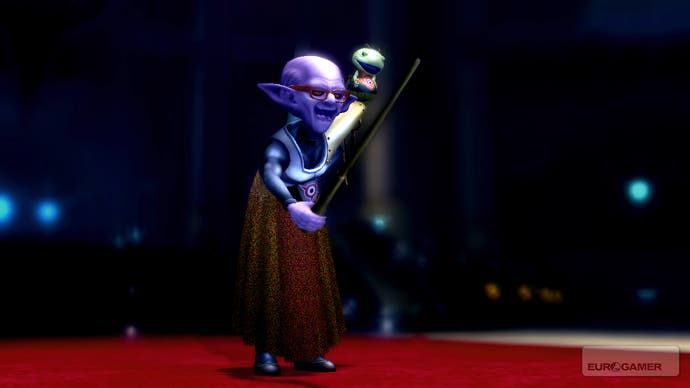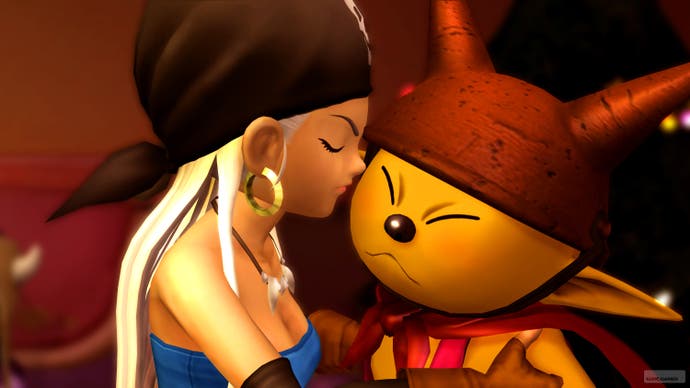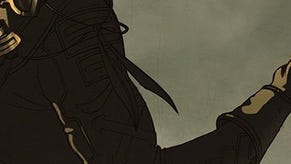Blue Dragon
It drags on and on.
We understand the rationale, we really do. The Xbox 360 is going down in Japan in a manner which makes lead balloons look like a sound investment, and Something Needs To Be Done. What does Japan like? It likes Final Fantasy, and it likes Dragon Quest. A lot.
Solution, then; hire the bloke who invented Final Fantasy, the bloke who did the music for Final Fantasy, and the chap who draws the characters in Dragon Quest, and get them to make a game.
Blue Dragon is the result - and perhaps, if you're Japanese and deeply attached to the creations of the three men involved with it, it might tick all the boxes for you. It's graphically stunning (tick), absolutely enormous (tick), and dripping with nostalgia for an earlier age of RPGs (tick - well, maybe).
Blue in the Face
The game starts out in a dusty yet idyllic village somewhere out in a desert, and the intro sequence alone is enough to prove that it's a looker. Environments are lovingly constructed and textured, with a careful balance struck between realistic visual effects and a cartoonish art style. Water sparkles, metal glistens, dust rolls off sand and light gleams off polished surfaces, but it's all handled in an understated fashion which doesn't overwhelm the bright, colourful artwork.

Characters, meanwhile, are rendered in broad, stylised strokes - faithfully interpreting Akira Toriyama's designs, and giving them the appearance of plastic models rather than cel-shading them. It's an effect which works remarkably well; the removal of the heavy black borders seen in cel-shading serves up quite a different effect to that which we're used to with cartoon characters in games, and gives characters a strangely realistic edge.
Less realistic, though, is the unusual lack of facial animation on any of the characters. Their lips move as they speak, but for the most part the rest of their faces are entirely static - which pretty much limits the range of their emotions to those which can be expressed by waving arms and jumping up and down.
It rapidly transpires, however, that that's not a problem. Blue Dragon doesn't make any demands from its characters in terms of emotional range, at least not any that can't be expressed by jumping up and down. The game hinges on a storyline which would be embarrassingly simple in a children's cartoon show - three kids live in a fairly primitive village which is attacked every year by the powerful Land Shark. They decide to take on the shark, and end up being dragged off by it.
Eventually they discover that the "shark" is actually mechanical, and is being controlled by a nasty old bloke called Nene who lives in a flying fortress surrounded by purple clouds. Purple is evil, see? Nene is tormenting the villages on the planet below him, apparently because he's Eeeeeevil, and has an Eeeeeevil plan which seemingly involves pissing everyone off until they go and hunt down powerful artefacts from the lost civilisation whose ruins are buried under the surface.

That's about it. You cover this plot within about an hour of starting off the game, and what remains is a quest all over the planet's surface to visit every clichéd village archetype in the RPG bible and sort out whatever nastiness Nene has been causing there. Each of your characters (your initial three are joined by a fat yellow squeaking idiot who gave us murderous thoughts within a matter of seconds, and later by a young pirate woman who is about the only genuinely likeable character in the whole game) has a paper-thin backstory of their own, but they're every bit as predictable as you might imagine.
Singing the Blues
This is, in other words, a throwback - an archaeological relic of a storyline, excavated from the caves of an ancient civilisation which thrived in Japan in the 1980s and most definitely wasn't more advanced than our own. There is no emotion, no subtlety - no double cross you can't see about twenty miles off, no character with hidden and intriguing motives, no extraordinary backstory to uncover, no political machination or moral uncertainty.
The entire storyline, in effect, is a weak excuse to drag you through the game's locations fighting various monsters and leveling up your characters - and here, at least, Blue Dragon scores some brownie points for itself.

The combat system in the game is nothing if not traditional, being strictly turn-based and heavily focused on the sort of magic and physical attacks which defined early RPG efforts in Japan. The central conceit is that your characters don't actually fight, apart from in the first half hour or so of the game; instead, giant magical shadow-beasts which appear behind them in play do the fighting.
In practice, this is a nice visual effect but has remarkably little impact on how the combat system actually works. You can't control your characters independently of their Shadow beasts, so in essence you just issue turn-based commands as normal, and the Shadows carry them out. You can fiddle with the class of your Shadows, changing and improving their abilities, as you progress - but this, again, is no different in practice to fiddling with character classes in RPGs dating back to the SNES era.





